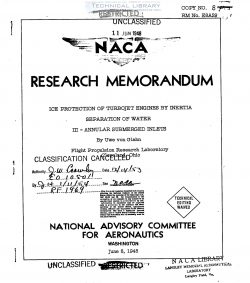naca-rm-e8a29
- Version
- 118 Downloads
- 697.44 KB File Size
- 1 File Count
- April 21, 2017 Create Date
- April 21, 2017 Last Updated
National Advisory Committee for Aeronautics, Research Memorandum - Ice Protection of Turbojet Engines by Inertia Separation of Water - III - Annular Submerged Inlets

An investigation was made of annular submerged inlets designed
to prevent the entrance od.’ water into a turboaet engine in an icing
condition. The results show that, in order to be effective in
maintaining water-free induction air, the inlet gap must be extremely
small with a high inlet-velocity ratio; ram-melsure losses conse-
quently are high. For practical purposes, all inlets investigated.
admitted. moderate quantities of water and a considerable mount of
compressor-inlet screen icing was observed. Annular inlets are also
aerodynanically unsuitable because of the severe mass-flow shifts
occurring in the inlet at angles of attack.
An inlet that prevents the entrance of water droplets while
mintaining good aerodynamic characteristics constitutes a funda-
mental approach to the ice protection of turboaet engines. A non—
ramming inlet that may prevent the entrance cf water into the engine
is the submerged or flush inlet. Such inlets must maintain good
ram-presstn‘e recovery and at the same time exclude water. Recent
research at Ames Aeronautical Laboratory on the submerged side-
inlet-type or flush side-inlet-type air intake has shown that total-
pressure recoveries of approximtely 92 percent can be attained
with a nomamming inlet and that the side inlets are comparatively
unaffected by angle of attack.
The aerodynamic performance of annular submerged inlets is a
function of the location of the inlet with respect to the surface
static-pressure gradient, the boundary layer ahead of and. in the
inlet, the inlet-velocity ratio, the ramp and. diffusion angles, and
the degree of surface flushness of the inlet lip. A mall layer
above a curved surface is free of water because of water deflection
by the body (reference 1). If the small water-free layer is thick
enough and. additional separation is gained by a small inertia-
separation effect at the inlet, the design of an ice-free inlet
should. be possible. At a large angle of attack, the bottom quarter
of an annular inlet may be subject to direct impingement of water
droplets.
Aerodynamic and preliminary icing studies were conducted in
the 6- by 53-foot high-speed test section of the NACA Cleveland.
icing research tunnel on a one-half scale model of an annular sub-
merged inlet for use with an axial-flow turboJet engine. The
results are presented in terms of ram-pressure recovery, radial
velocity profiles, and icing characteristics. The purpose of this
investigation was to determine the general aerodynamic performance
characteristics of several annular submerged inlets under icing
conditions and to determine the extent to which water intake into
the engine could be prevented by suitable inlet design.
| File | Action |
|---|---|
| naca-rm-e8a29 Ice Protection of Turbojet Engines by Inertia Separation of Water - III - Annular Submerged Inlets.pdf | Download |

Comment On This Post